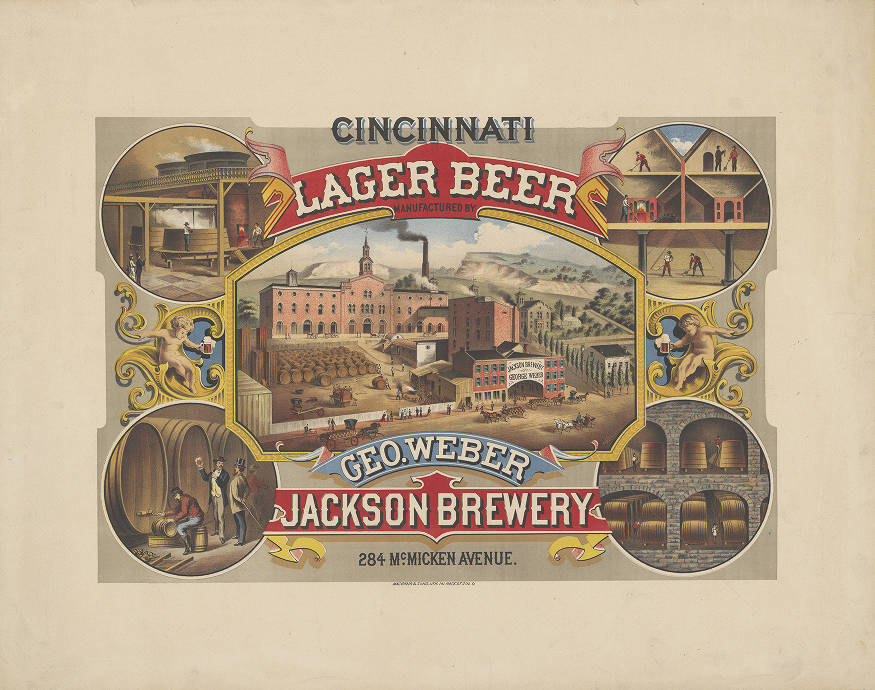Beer Workers in Over the Rhine Organizing for Change in Cincinnati

Besides iron work, furniture, printing, and machinery, an important industry in the late 19th century in Cincinnati was brewing beer. The large influx of German immigrants arriving after the failed revolution of 1848 brought many skilled workers to Over the Rhine, where beer was probably more heavily consumed than water, and may have been safer to drink. Some of the downtown bars advertised "free wurst with your beer."
Conditions were not great in these breweries - low wages, very long hours, and extreme temperatures were difficult to tolerate - especially among a group of workers who knew a bit about organizing from their time in German.
According to one report, the very first workers' sit-down strike in the US happened here at the Jackson Brewery, just up the hill from W. McMicken at Elm in 1884. As described in the IWW's One Big Union Monthly of October 1937, at that time many brewery laborerers had to live at the workplace in dormitory-like spaces so that they could be available to work whenever needed by the boss. In summer 1884 they grew tired of these very long days and organized a "Folded Arms" demonstration and asked the bosses to leave, barricading themselves inside the beer barrels. The dispute was settled peacefully in a few days and combined with similar organizing in other cities led directly to the formation of the United Brewery Workers union. By sitting-in at the brewery, the workers were able to prevent the bosses from bringing the strike-breakers, which had led to the loss of a strike in 1881.
These sit-in details are hard to corroborate, since they were written up by a former editor of the Brewery Workers Union newsletter (William Trautmann) who only moved to Cincinnati in 1900, but the working conditions were confirmed in a 1901 article in the union's newsletter. Details from the translation from the German are especially interesting: the workers were referred to as "peons", and the dorm arrangements were referred to as "confinement" - clearly not voluntary. That newsletter also pointed out that women and children as young as 10-12 were having to tolerate these working conditions.
In 1887 the AFL chartered this first industrial union of brewery workers - which by the 1930s represented all workers in the industry with the exception of a few workplaces in the Pacific northwest. In 1910 Herman Schlueter authored a history of the union, including a detailed chapter on accidents and industrial diseases among brewers. The main causes were reported to be the great variations in temperature, the higher speed of the machinery, and the excessive use of alcohol. Some workers in the malt kiln rooms (drying sprouted barley) had to withstand temperatures well above 110 degreees, and then had to move to cold temperatures in the cellar or outdoors. (Schlueter's book is available online at books.google)
At that time the union had about 1,300 members in Cincinnati's eight breweries along Vine, Sycamore, and McMicken, with three local unions divided by craft, as was typical for AFL unions of the time: brewers, drivers, and bottlers. Some of their first demands were for shorters days and a reduction of Sunday hours from 8am to 4pm.
In an important chart, Schlueter reports wages and work hours before and after getting organized, with wages increasing 20-30% and hours typically being reduced from 14 to 10 hours per day. For the first 15 years, all of the business of the brewers union was conducted in German. Union meetings were held in Turners Hall on Walnut St., one of eight "Turnvereine" in Cincinnati - centers for exercise and cultural enrichment in eash US city with large German immigrant populations. These institutions became gathering places for "radical democrats" in various cities, including Milwaukee and St. Louis. Later the headpuarters of the brewers union moved to 2347 Vine St., a building that's still there opposite Inwood Park. In 1973 the Brewery Workers union merged with the Teamsters and the workers today at Sam Adams are respresented by that union.